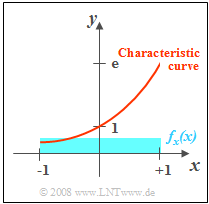Exercise 4.2Z: Correlation between "x" and "e to the power of x"
Let the random variable $x$ be uniformly distributed between $-1$ and $+1$. Thus,
- the mean $m_x = 0$, and
- the variance $\sigma_x^2 = 1/3$.
By the nonlinear characteristic $y = g(x) = {\rm e}^x$ the random quantity $y $ is formed. Thus, there is a fixed deterministic relationship between the two random variables $x$ and $y$. The random variable $y$ can only take values between $1/{\rm e}$ and ${\rm e}$.
For the probability density function, one obtains for this range according to the principle "Transformation of Random Variables":
- $$f_y(y) = {\rm 1}/({\rm 2\it y}). $$
Hints:
- The exercise belongs to the chapter Two-Dimensional Random Variables.
- Reference is also made to the chapter Expected Values and Moments.
- Consider that in the range $-1 ≤ x ≤ +1$ the exponential function can be approximated as follows:
- $$y={\rm e}^{x}\approx 1+ \frac{ x}{1!} + \frac{{ x}^{\rm 2}}{\rm 2!}+ \frac{{x}^{\rm 3}}{\rm 3!}+ \frac{{x}^{\rm 4}}{\rm 4!}.$$
Questions
Solution
- A second calculation possibility is based directly on the calculation rules for expected values:
- $$m_y={\rm E}\big[ y\big] = \int_{-\infty}^{+\infty}g(x) \cdot f_x(x)\,\, {\rm d}x = {1}/{2}\cdot\int_{-1}^{1}{\rm e}^{ x}\,\,{\rm d}x=\rm {1}/{2}\cdot(e-e^{-1}) \hspace{0.15cm}\underline{= 1.175}.$$
(2) For the second moment (second order moment) of the random variable $y$ holds:
- $$m_{2 y} = {\rm E}\big[ y^{\rm 2}\big] = {\rm E}[{\rm e}^{ 2 x}]= {1}/{2}\cdot\int_{-1}^{+1}{\rm e}^{2 x} \,\,{\rm d}x = {1}/{4}\cdot({\rm e}^{2}-{\rm e}^{-2}) = 1.813.$$
- From this we obtain by Steiner's theorem:
- $$\sigma_y^{\rm 2} = m_{ 2 y}- m_{ y}^2 = {1}/{4}\cdot({\rm e}^{2}-{\rm e}^{-2})-{1}/{4}\cdot( {\rm e}^{2}-2+{\rm e}^{-2})={1}/{2}\cdot(1-{\rm e}^{-2})=0.432 \hspace{0.3cm} \Rightarrow \hspace{0.3cm}\sigma_y \hspace{0.15cm}\underline{= 0.658}.$$
(3) Correct are the proposed solutions 1, 3 and 4:
- Outside the curve $y = {\rm e}^x$ the PDF is of course zero.
- Since the volume under the 2D–PDF is equal to $1$, the PDF values for the infinitely narrow region are infinite $y = {\rm e}^x$.
- This means that the PDF describes a curved Dirac wall.
- Due to the decay of the PDF $f_y(y)$ with increasing $y$, the height of this Dirac wall decreases continuously from $(-1, 1/{\rm e})$ to $(+1, {\rm e})$ .
(4) For the joint moment holds:
- $$m_{xy} = {\rm E}\big[ x\cdot y \big] = {\rm E}\big[ x\cdot {\rm e}^{x} \big].$$
- With the series expansion given, the approximation follows:
- $$m_{xy} \approx {\rm E}\big[x\big] + {\rm E}\big[x^{\rm 2}\big] + \frac{1}{2} \cdot {\rm E}\big[ x^{\rm 3}\big] + \frac{1}{6} \cdot {\rm E}\big[ x^{\rm 4}\big]+ \frac{1}{24} \cdot {\rm E}\big[ x^{\rm 5}\big].$$
- Because of the symmetry of the random variable $x$ holds for all odd values of $k$: $\rm E\big[\it x^{k}\rm \big] =\rm 0.$ Furthermore:
- $${\rm E}\big[ x^{\rm 2}\big] = \sigma_{x}^{\rm 2}= \frac{1}{3}, \hspace{0.5cm} {\rm E}\big[ x^{\rm 4}\big] = \frac{1}{2}\int_{-1}^{+1} x^{\rm 4} \,\,{\rm d}x = \rm\frac{1}{5}\hspace{0.3cm} \Rightarrow \hspace{0.3cm}{\it m_{xy}} = \rm\frac{1}{3} + \frac{1}{6}\cdot\frac{1}{5} = \frac{11}{30}\hspace{0.15cm}\underline{\approx 0.367}.$$
(5) Because of $m_x = 0$ holds $\mu_{xy} = m_{xy}$. Thus, for the correlation coefficient:
- $$\it \rho_{xy} = \frac{\mu_{xy}}{\sigma_x \cdot \sigma_y}=\rm\frac{0.367}{0.577 \cdot 0.658}\hspace{0.15cm}\underline{ \approx 0.967}.$$
- Between $x$ and $y$ there is indeed a definite deterministic relation.
- But since there are also some nonlinear bindings in this, the correlation coefficient $ \rho_{xy} \ne 1$.
